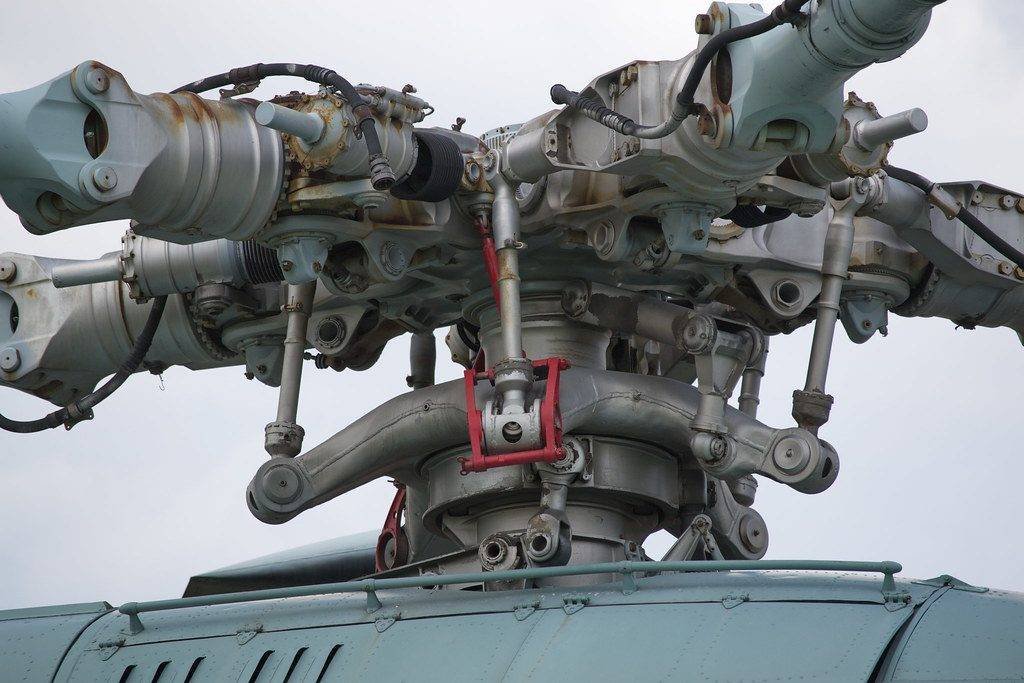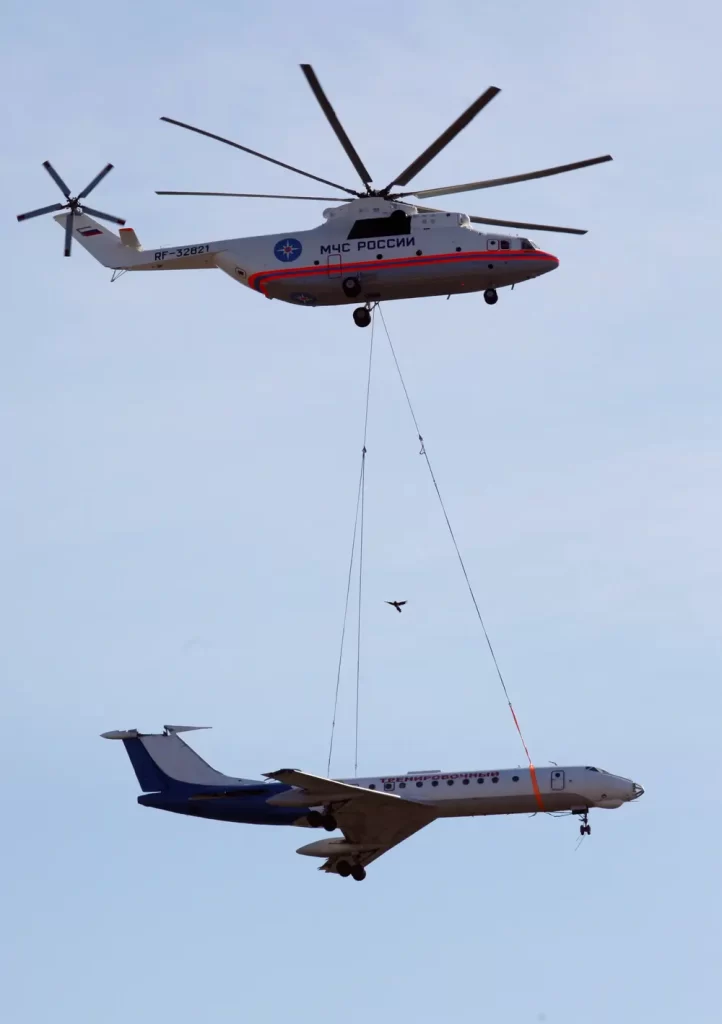The Mil Mi-26 (NATO Nickname: Halo) is a Soviet/Russian heavy transport helicopter that was designed and developed by the Mil Moscow Helicopter Plant. It is the largest helicopter ever built, with a maximum takeoff weight of 56 tons. The helicopter was first introduced in the late 1970s and entered service in Russian air force in 1983.
The Mil Mi 26 was designed to transport cargo and troops over long distances, as well as to perform heavy-lift missions such as the transportation of large and heavy military equipment.
Variants of Mi 26 Helicopter
The Mil Mi-26 helicopter has several variants that have been developed over the years. Some of the main variants include:
- Mi-26: This is the original production model of the helicopter, which entered service in 1983. It is primarily used for cargo transport and heavy-lift operations.
- Mi-26T: The Mi-26T is a transport version of the the Mi-26 that is equipped with a cargo winch and a loading ramp, which allows it to load and unload cargo more easily.
- Mi-26T2: The Mi-26T2 is an upgraded version of the Mi-26T, which features improved avionics and engines, as well as a strengthened airframe.
- Mi-26A: The Mi-26A is an airborne command post variant, which is equipped with a variety of communication and control systems.
- Mi-26S: The Mi-26S is a search and rescue variant of the helicopter, which is equipped with a rescue hoist, a winch, and a FLIR (Forward-Looking Infrared) system.
- Mi-26M: This is a medical evacuation variant which is equipped with a medical module, which includes equipment and supplies for patient care, and a loading ramp.
- Mi-26MS: A variant of the Mi-26M equipped to perform heavy fire-fighting operations.
- Mi-26P: A variant of the Mi-26 equipped with a powerful water cannon, which allows it to perform fire-fighting and disaster relief operations.
These are some of the main variants of the Mi-26 helicopter, but there are other specialized models that have been developed for specific roles and operations.
Mi-26 Helicopter Design Features
The Mi-26 heavy lift helicopter helicopter is designed with several key features that allow it to perform heavy-lift and transport missions effectively. Some of these features include:
- Large cargo compartment: The Mi26 cargo compartment can accommodate up to 20 tons of cargo, or up to 90 fully equipped troops. The cargo compartment is accessible through a rear ramp that can be opened in flight.
- Wide-track landing gear: The Mi-26 has a wide-track landing gear that allows it to land on unprepared surfaces, such as dirt or gravel. This is particularly useful for operations in remote areas or in disaster relief scenarios.
- High-strength construction: The Mi-26 is built with high-strength materials such as titanium and composites, which allow it to withstand the stresses of heavy-lift operations and to operate in harsh environments.
- Advanced avionics: The Mi-26 is equipped with advanced avionics, such as a navigation system, a weather radar, and a communication system. This allows the helicopter to fly in adverse weather conditions and to navigate with precision.
- High-performance rotor system: The Mi-26 is equipped with a high-performance rotor system that provides exceptional lift and stability, even in high-altitude and high-temperature conditions.
Engine

The Mi-26 is a powerful helicopter is powered by two Lotarev D-136 turboshaft engines. The Lotarev D-136 is a high-performance engine that was developed specifically for the Mi-26. It has a maximum power output of 11,400 horsepower, which enables the helicopter to have a maximum takeoff weight of 56 tons and a maximum speed of 295 km/h (183 mph).
The D-136 engine is equipped with a two-stage low-pressure compressor, a high-pressure compressor, an annular combustion chamber, and a two-stage turbine. It also has a FADEC (Full Authority Digital Engine Control) system, which provides automatic control of the engine’s power and performance. The engine also features an anti-icing system that prevents the accumulation of ice on the compressor blades, which improves engine efficiency and safety.
The D-136 engine is known for its reliability, durability and high performance, it can operate in a wide range of temperatures and altitudes, and it requires minimal maintenance. This makes it well suited for heavy-lift and transport operations, which are the primary roles of the Mi-26 helicopter.
Pay Load Capacity

The Mil Mi-26 helicopter has a maximum payload capacity of 20 metric tons (44,092 pounds). This means that it can carry up to 20 tons of cargo, or up to 90 fully equipped troops.
The helicopter’s large cargo compartment is accessible through a rear ramp that can be opened in flight. This allows for easy loading and unloading of cargo and equipment, and allows the helicopter to perform heavy-lift operations such as the transportation of large and heavy equipment. Additionally, the helicopter has a cargo winch and a loading ramp, which allows it to load and unload cargo more easily.
It’s worth noting that the payload capacity of the helicopter is affected by several factors such as altitude, temperature, and the weight of the fuel. The helicopter’s performance is also affected by the weight of the payload, as a heavy payload will reduce the helicopter’s speed, range and manoeuvrability. So, the payload capacity is an important consideration when planning a mission, and the helicopter’s capabilities must be taken into account to ensure that the payload is within the helicopter’s safe operating limits.
The helicopter’s versatility and heavy-lift capabilities make it a valuable asset for many different types of military operations.
The Mi-26 has been used to transport troops and supplies, and to perform air assaults. The helicopter has also been used to transport tanks and other heavy equipment. It has been used in several military conflicts, including the Soviet-Afghan War, the Gulf War and the Syrian Civil War.
The World’s biggest helicopter has been used by many countries around the world, primarily in the former Soviet Union and other countries of the Eastern Bloc, but also in India, Mexico, South Africa and Peru among others.
In conclusion, the Mil Mi-26 helicopter is a powerful and versatile aircraft that has been used for a wide range of roles, including cargo transport, search and rescue, and firefighting, military operations, and civilian purposes such as construction, oil & gas, and mining. Its large cargo compartment, powerful engines, and advanced avionics make it well suited for heavy-lift and transport operations, and its wide-track landing gear allows it to land on unprepared surfaces, making it ideal for operations in remote areas or disaster relief scenarios. The Mi-26 is known for its reliability, durability, and high performance, with a high-strength construction and a high-performance rotor system. The helicopter’s versatility and heavy-lift capabilities make it a valuable asset for many different types of operations, making it a significant helicopter in the world.


